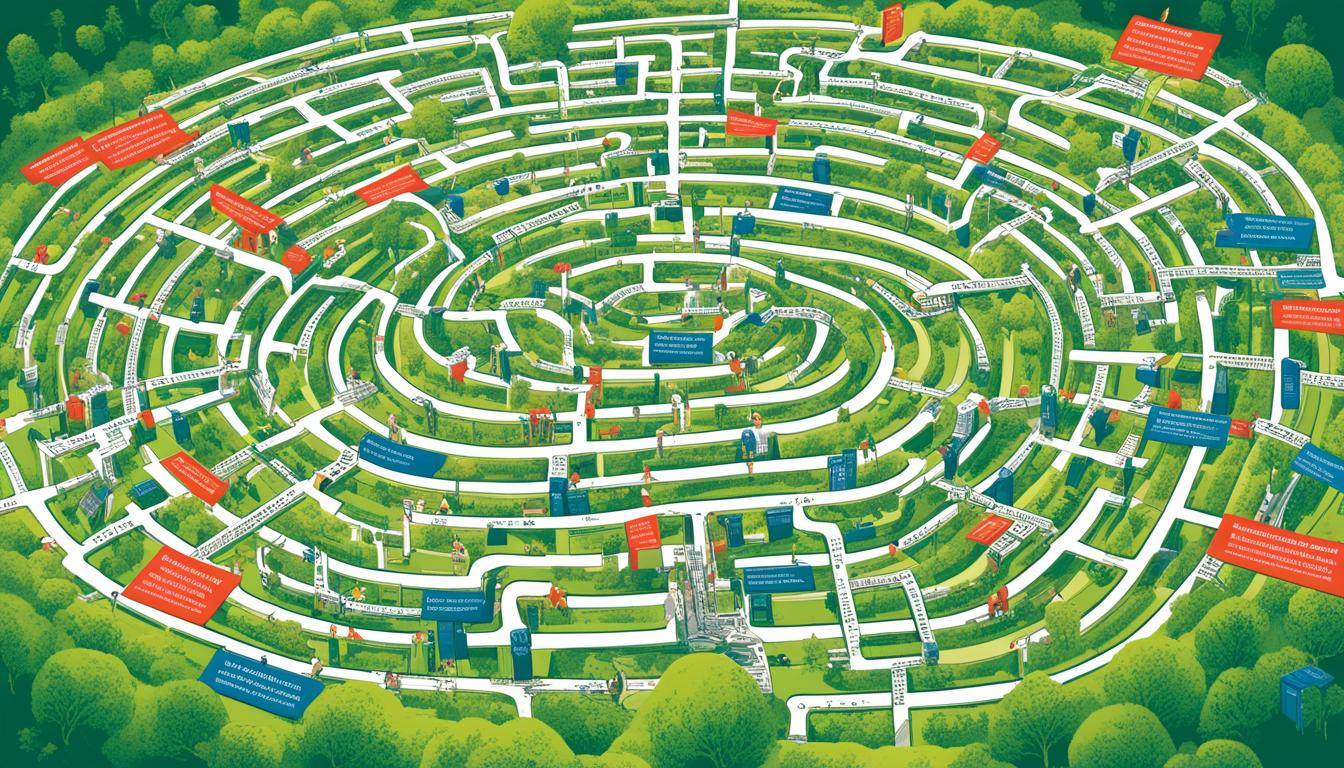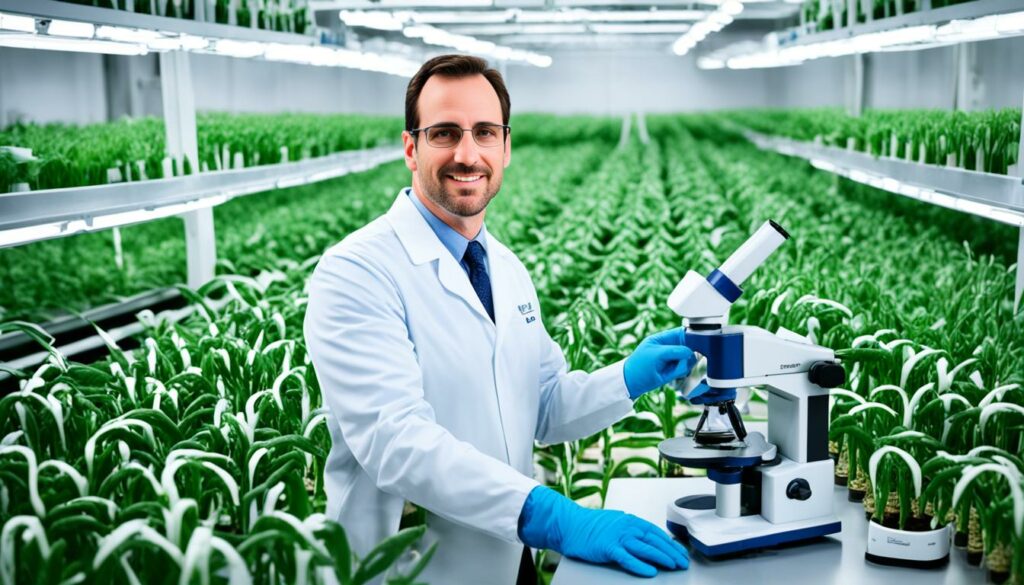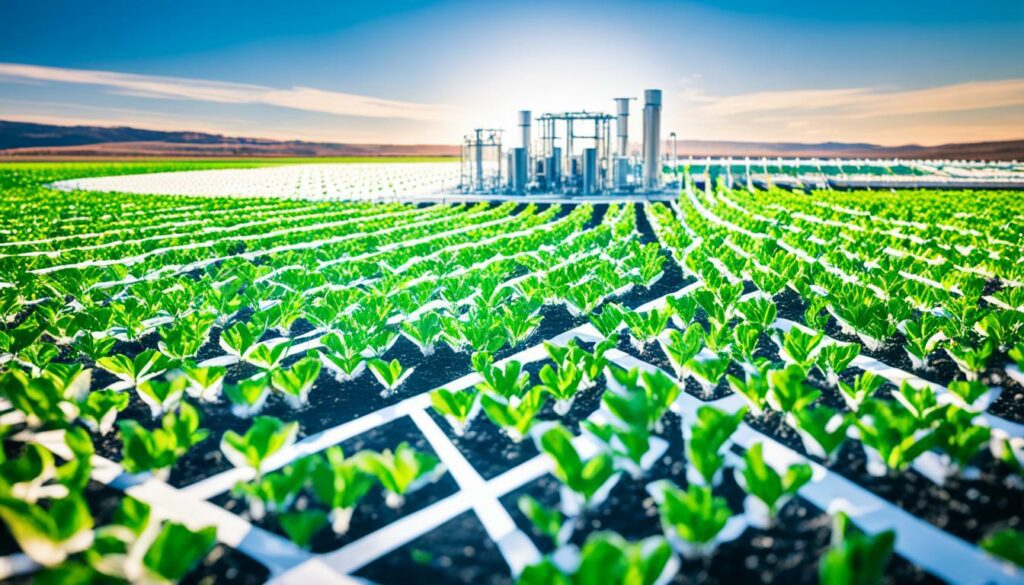Menu

Did you know the US has regulated biotechnology since 1986? This framework highlights the country’s effort in managing agricultural biotech. With regard to products coming from biotechnology, it focuses on their safety for the environment and health. The USDA-APHIS, EPA, and FDA are key in this, working together to ensure the public is safe.
The Coordinated Framework for Biotechnology began in 1986. It brought together the USDA, EPA, and FDA. Their goal is to keep us safe from harm and protect the environment. New rules are added as science marches on.
In 1984, the idea for the Coordinated Framework for Regulation of Biotechnology started. It was fully set up in 1986. This framework said existing laws could cover biotech products. It also stated genetically modified plant foods should follow food law.
This was key because different government groups now work together. They help keep an eye on new technologies safely.
This setup covers many important laws. The Plant Protection Act, for example, lets the USDA watch over genetically changed crops. Then there’s the rule that by 2022, genetically changed foods must be clearly marked. These and more are the main rules for biotechnology.
Three US groups work together on biotechnology:
Each group has a big job. They help make sure biotechnology is safe and does what it should.
The White House Office and other government areas have been working hard to update biotech rules. This includes Executive Order 14081. They want to use new efforts like the NBBI to keep us safe and move science forward.
To wrap it up, the USDA, EPA, and FDA do a lot to watch over biotechnology. By making and updating rules, they make sure these products are safe and work well.
The USDA’s APHIS is key in agricultural biotechnology. It enforces regulations under the Plant Protection Act. Their main goal is to shield the nation’s farms from plant pests and diseases. They ensure the safety of bringing, managing, and letting out genetically altered organisms.

The Plant Protection Act lets USDA-APHIS control genetic engineering. This is important in handling organisms that could be harmful to plants. By regulating these biotech products, APHIS helps keep farming safe.
USDA-APHIS sets out clear steps for bringing in, dealing with, and setting free genetically engineered organisms. These steps are aimed at reducing the risks linked to these products. The agency makes sure that all such products meet safety criteria to safeguard nature and farming.
Firms can ask APHIS for non-regulated status for biotech products. This asks for lots of details showing the product is not a plant pest risk. APHIS then looks at how these products might affect farming and the environment. The goal is to add new biotech in a way that keeps farms safe.
President Biden signed Executive Order 14081, pushing the U.S. EPA to work with the FDA and USDA. Together, they’re updating how they regulate biotechnology products. This work is important as biotechnology changes quickly, needing strong, clear rules.
Under laws like FIFRA and FFDCA, the EPA checks that pesticides, even those from biotechnology, are safe and work well. These rules cover everything from selling to using these pesticides. They make sure our food and environment stay safe. The EPA also decides how much of a pesticide can be in our food before it’s harmful.
At the EPA, the Biopesticides and Pollution Prevention Division focuses on biopesticides. It aims to reduce pollution and improve safety by supporting new, natural pest control methods. Operating under laws like FIFRA and FFDCA, this group carefully checks biotechnology-based biopesticides. They ensure these products are safe for us and the planet.
The EPA’s job includes setting how much pesticide can be in our food without harm. They do this to keep us safe from dangerous residues. The EPA looks at scientific facts to choose these safe levels. This way, they protect our health and push for stronger rules on biotechnology and pesticides.

The Food and Drug Administration (FDA) is key in making sure biotechnology products are safe. It mainly watches over food and feed safety and the clear labelling of genetically engineered items. Since the start of biotechnology, the FDA has focused on the safety and use of these products. They follow strict policies to make sure these items are safe and labelled correctly.
The FDA demands high safety standards for all genetically engineered items. They work closely with other organisations like the USDA and EPA. This teamwork ensures a strong, unified system. The FDA also looks after clear food labels to inform people about what they’re eating. This builds trust in products from biotechnology.
The FDA also supports a voluntary consultation to get new biotech products to market smoothly. This method lets developers talk with the FDA early. They check if the products are safe for food and feed. This makes sure products are safe before they go on sale. The process includes a detailed look at scientific data. It helps guide developers while encouraging new, safe products.
The FDA carefully checks food additives from genetically engineered sources. Any new biotech food additive must get FDA approval before it’s sold. This makes sure these additives are safe for people. The FDA offers helpful documents and information. This helps developers know how to get their food additives approved. It supports safety in the whole industry.
In essence, the FDA ensures biotech products are safe through tough safety checks, clear labels, and helpful consultations. Their work means the good parts of biotechnology can be enjoyed safely, helping both people and farming.
The government’s role in shaping biotechnology in the United States is massive. It does this through a coordinated effort across all departments. This includes using biotechnology executive orders to maintain safety, efficiency, and ethical practices in the sector.
In September 2022, President Biden issued a significant Executive Order. It aimed to boost biotechnology and biomanufacturing. This is part of a wide national biotechnology strategy that seeks to drive innovation, economic growth, and better public health through cutting-edge biotech projects.
Biotechnology legislation’s key challenge is balancing innovation with keeping people and the environment safe. The U.S. government uses several agencies, such as the USDA, EPA, and FDA, for a thorough safety check. This ensures that biotech products, like genetically engineered crops, are safe for us and the planet.
There’s a clear effort to keep evolving the rules around biotechnology. This involves updating policies to keep up with new science. It’s also about addressing the public’s worries regarding safety and ethics of biotech products.
| Agency | Role |
|---|---|
| USDA-APHIS | Regulates plant pests or risks and oversees non-regulated status petitions. |
| EPA | Oversees pesticides from biotech products, setting tolerance limits. |
| FDA | Ensures safety and proper labelling of genetically engineered food and feed. |
In our world, the population is growing fast and will hit 9 billion by 2030. To feed everyone, we need new ways in biotechnology. These methods help produce more food without harming the earth.

A study by Ray et al. found that crop yields need to increase more to match our growing population. Biotechnology helps here by boosting crop growth and quality. It also fights off plant diseases and weeds, all while protecting the environment.
Biotechnology is also making farming safer for the earth. It cuts down on synthetic pesticides, keeping our water clean. Plants like soybeans, cotton, and corn now resist pests naturally. This means, we use fewer harmful chemicals on our food.
Sustainable farming aims to keep our land, water, and wildlife healthy. It does this by using smart, natural techniques to get the most food out of every plot. Biotechnology is key to this, helping us face climate change and feed the world.
Agricultural biotech has already scored big wins. It saved the U.S. papaya industry from a deadly virus, for example. Now, it’s working on making crops that can grow in tough conditions and have more nutrients. These efforts are vital for our future food supply.
People from many fields join hands to make farming better. This includes scientists, engineers, and economists. Their work helps create strong farms that can deal with changing climates. Over 29 countries grow genetically engineered crops, showing the global power of biotech.
Organisations like the USDA, EPA, and FDA work together to check genetically engineered crops. They make sure these crops are safe for us and the planet. Their work is key for a healthy and sustainable future in farming.
Environmental impact assessments are key in biotech crop approval. They check how GMOs might affect nature. These assessments help ensure biotech crops do little harm to the environment.
The steps for assessing impacts on the environment are clearly set. They focus on how biotech crops touch non-targets, the soil, and plants. Each check follows strict environmental rules to make sure biotech crops are safe and green.
In 2012, the USDA’s NASS showed biotech crops were big in the US. They made up most of the corn, cotton, and soybean crops. This shows why we need strong rules for the environment.
Many studies back biotech crop approval. For example, they cut pesticide use by 503 million kg worldwide. This is an 8.8% drop. The crops’ overall environmental score also improved by 18.7%.
Biotech crops also helped reduce greenhouse gases. In 2012, they cut emissions as much as taking almost 12 million cars off the road. This shows how effective crop approval checks are at making farming greener.
Using these checks with biotech crop approval helps mix them safely into farming. This way, environmental damage is less, and nature stays strong.
Getting the right funds is key to push agricultural biotechnology research forward. Both public and private money play a big part in making new innovations happen. This is crucial for growth in this vital field.

Worldwide, public money into agricultural research gives back about 50% each year. In the US, since 1862, the land-grant university system and the USDA have helped a lot. They work together for research and outreach, supporting innovation across different states.
Public and private partnerships are key in agricultural biotechnological research funding. They bring together money and skills from both sectors, making innovation happen faster. These partnerships help meet the demands of the market and society, ensuring long-term progress in agricultural technology.
Agricultural biotech research funding makes a big difference, leading to significant advancements and better returns on investment. Funds in technology research in the US showed returns of 95% from 1927 to 1950. And science-focused research had even higher, reaching 110%. Today, a focus remains on tracking and boosting the use of biotech crops. This helps enhance the quality, safety, and competitiveness of American agriculture.
Agricultural biotech policies have a big impact on crop technology. They shape how research, development, and selling of GMOs happen. Because of these policies, the field of crop technology moves forward. Over 29 countries grow genetically engineered crops, showing the value of good regulations.
Also, 42 countries buy genetically modified crops. This points to a strong global trade thanks to good policies. These rules play a key role in safe trading and keep people and nature safe. As technology grows, so should the rules around it, to deal with new situations.
Effective agricultural biotech policies are crucial to harnessing the full potential of genetically modified organisms, ensuring sustainable and productive agricultural practices.
Working towards common global goals, as seen in biotechnology frameworks, helps innovation. This key connection affects research and how markets work, among other things.
Looking at a table showing where biotech crops are grown and sold can help us understand this better.
| Region | Countries Growing Biotech Crops | Countries Importing Biotech Crops |
|---|---|---|
| Latin America | 10 | 42 |
| Africa | 6 | 42 |
| North America | 2 | 42 |
| Europe | 2 | 42 |
| Asia | 9 | 42 |
So, these policies are key in letting countries enjoy GMO benefits and in developing crop technology for the future of farming.
International trade is key in today’s world economy, especially for farming technology trade. With the world’s population growing from 6.5 billion in 2005 to 8.1 billion today, the need for farming goods is quickly rising. The WTO SPS Agreement and the USMCA are major deals that shape global trade in items like GE crops. Learning about them is important to understand how to trade successfully.
The WTO SPS Agreement ensures that goods traded globally are safe. Countries can make their own rules for food and plant safety as long as they are scientifically proven to be necessary and don’t block trade. The goal is to make sure that trade in farming technology is fair, safe, and doesn’t harm the environment. This is very important because we need to produce more food in the coming years to feed everyone.
The USMCA was set up in 2017 to boost trade and safety in farming technology between the US, Mexico, and Canada. It focuses on making trading non-harmful, safe crops easier. New rules from the USDA also make it quicker to approve some GE seeds. This helps keep the US competitive in global trading.

The way nations trade with each other is always changing. This will certainly affect how we deal with farming technology in the future. New farming technologies, like those that help the US grow more crops, could really help feed more people around the world. Future trade deals need to encourage these new technologies while keeping trade safe and friendly. They should help countries work together to make sure we trade safely while using the newest farming methods.
Understanding how consumers see GMOs is key for making and managing biotech products. For example, a study with an auction in 2001, 172 consumers from the Midwest took part. They found that info really changes how people bid on biotech foods. Those who heard only bad info about biotech foods bid much lower, 35% less actually. This shows a big issue in teaching consumers.
Teaching consumers the right things helps join science facts with what people think. The same 2001 study showed how mixed info reduced the price gap on biotech foods. This means giving the full scientific story helps people see biotech foods in a better light.
The study also found that explaining the good of biotech foods won over many people. To be exact, 40.87% of those in the study liked hearing this. This shows clear benefits can change how people feel.
Labelling biotech products also really affects what consumers choose. Around 51% said they want to see biotech amounts marked clearly. And, nearly half think a special logo on the package matters most.
Other important points were what the label said (40.87% found this important) and where the logo was on the pack (10.43%). This underlines the need for labels that are easy to understand and right to the point. This helps consumers know what’s in their food and clears up any false ideas about biotech.
“Consumers reacted more to scientific information than to pro-biotech information from leading biotech companies, with an average price discount between 16% and 29% for biotech-labeled foods.”
These findings make it clear that teaching consumers about GMOs and using smart labelling can change how people see and choose biotech foods. With good science info and clear talk, we can fight wrong ideas and help people understand biotech better.
The world of GMOs in the US is changing fast. This is thanks to new genetic engineering methods and updated policies. We’ll look into what’s coming next from three important views.

Genetic engineering keeps getting better, making GMOs more precise and effective. Scientists now can edit genes very accurately, cutting down on risks. In 2012, a big percentage of US corn, cotton, and soybean crops were GMOs. This shows how much we rely on GMOs and how they keep getting better at helping crops grow stronger and produce more.
With progress, though, come new rules and opportunities. The US uses several agencies like the USDA, EPA, and FDA to oversee GMOs’ safe use. They make sure GMO crops are safe for farming. Regulations are changing to keep up with new genetic methods. But, some rules are stricter, making sure GMOs are safe for the world and for trade.
The big challenge is getting policy and innovation to work together. Policies need to be flexible yet strong, keeping us all safe. International rules help set safety standards. As biotech grows, we need smart rules that keep us safe while allowing for new, better biotech.
It’s crucial we streamline the regulatory framework for biotechnology. This improvement leads to better use of agricultural biotech and biomanufacturing. President Biden’s recent Executive Order is a big step in this direction. It wants to make the most out of biotechnology. It also targets better streamlined biotech regulations, which are significant.
Working on easier regulations helps biotech companies a lot. They’re trying hard to show the good sides of their work. This makes people more likely to like and buy their products. Right now, rules against making GM stuff are hurting efforts to fight problems like not having enough food. New tech, for example, CRISPR gene editing, also adds to the need for better rules that also think about ethics and so on.
The Executive Order sets a 180-day deadline for some key actions. Leaders of key bodies like the Agriculture Secretary have to find the rules that can be made simpler. This is about making sure biotech products are still checked well. Also, they have to give updates every 90 days for two years on how this is going.
A helpful website on these rules should be ready within 6 months. It will make it easier for those making biotech products to understand the rules. Business should also plan on how to better talk to and win over the public about using biotech safely in farm and food work. There will also be a plan to make people in other countries like these products more and get rid of any unfair trade limits.
The need for better rules and clear roles in biotech has been clear for a while. Changes in how we manage biotech, made in 2015, aimed to fix this. They showed who in government does what in regulating biotech. By doing this, they want people to trust in new biotech things, and know they’re safe. The first big set of rules dates back to 1986. It set out how different government groups look after making sure biotech stuff is safe for people and the environment.
In the field of biotech, several laws are critical. They look after making food, drugs, stuff that kills bugs (pesticides), and getting rid of waste from a biotech standpoint. These laws give different government groups different parts to play in checking these products. Keeping these systems simple helps the biotech industry to continue making better things. This move is key for improving how agricultural biotech works and being competitive worldwide.
In the United States, the rules around agricultural biotech are crucial for progress. These rules help guide new ideas and ensure farming stays safe for the environment and our health. The USDA-APHIS, EPA, and FDA all work together. They focus on making sure biotechnology benefits our farms without causing harm.
The slow use of special crops in places like Africa and South Asia shows a real need for change. It’s important we make diverse foods more common to help with food security. But, using these crops often means lots of hard work to control weeds. Making new farming tools affordable is key. It helps smaller farmers and those who are struggling.
The USMCA is a big deal for these issues. It’s the first trade deal to think deeply about biotechnology in farming. Even though there have been problems, like Mexico taking time to approve some things, this deal matters. It shows the world that we can find good ways to use new agricultural technology.
The future of farming with biotechnology in the U.S. is all about moving forward wisely. Good rules, new science, and care for the earth must come together. This way, we can solve problems with food and farming for everyone, now and in the future.
Introduced in 1986, the Coordinated Framework for Regulation of Biotechnology is a set of rules. It checks the safety of new biotech products in America. The framework uses current laws and involves key bodies like USDA-APHIS, EPA, and FDA.
The United States Department of Agriculture’s USDA-APHIS, the EPA, and the FDA lead in regulating agricultural biotechnology. They work under the Coordinated Framework.
The USDA-APHIS watches over genetically engineered organisms. They do this through the Plant Protection Act. This includes checking them when they are imported, handled, or released to the environment.
For any organism to be exempt from regulation, a petition must be submitted. This process requires much information to ensure there’s no risk from plant pests.
The EPA looks after the sale, use, and testing of pesticides, including those in biotech products. They set safe levels for pesticide residues in food and feed to safeguard health and the environment.
The FDA is in charge of the safety and labelling of foods made from plants, including those that are genetically engineered. They urge safety checks and require approval before these products can be sold.
Crucial laws and orders shape US biotech action. These include those for innovation, safety, ethics, and keeping ahead in biotechnology and biomanufacturing.
Biotechnology helps meet the world’s food needs without harming the environment. It makes crops able to fight off pests and diseases, helping to farm sustainably.
Assessing the environmental impact of biotech crops is key. It’s part of the approval process, using set methods and standards.
Money for research comes from both federal and state schemes. Also, public groups and private firms work together to fund this research. This support is vital for progress in the industry.
Policies around biotech influence how new crop technologies are made. They affect how farming can be more innovative and sustainable over time.
Global trade deals, like the WTO and the USMCA, set rules for agricultural biotech. Future trade agreements will also influence these areas.
Consumer views on GMOs need clearer, science-based info. Good labelling lets people choose biotech foods knowing what’s in them.
The US will keep improving its GMO techniques. It aims to meet challenges with policies and new ideas in biotech.
Making regulations simpler helps innovation and efficiency. This keeps the US at the front in biotech around the world.